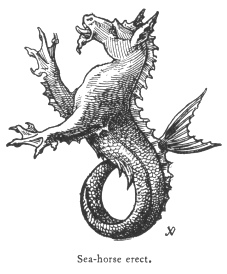
Sacred Texts Legendary Creatures Symbolism Index Previous Next
Buy this Book at Amazon.com


Fictitious and Symbolic Creatures in Art, by John Vinycomb, [1909], at sacred-texts.com
The steeds of Neptune are favourite subjects in ancient poetry and art in the triumphs and processions of the marine deities, drawing the chariot of the sea-god in its progress through the waves. The imaginative Greeks pictured to themselves the horses of Poseidon in the rolling and bounding waves as they pursue each other in haste towards the shore, "curling their monstrous heads." This may seem to account for the constant and close connection between the god and the horse. The origin of the horse is
ascribed to the contest between Poseidon and Athenæ as to who should make to mankind the most useful present; Neptune created the horse, Minerva the olive-tree.
The city of Lampsacus, in Mysia, founded by the Phoceans, adopted the winged sea-horse as their monetary type, in
 |
A coin of the celebrated Pyrrhus, King of Epirus (slain B.C. 272), the knight-errant of ancient heroes, represents the head of Achilles, the reputed ancestor of Pyrrhus, on one side, and the Nereid, Thetis, the mother of Achilles, on the sea-horse on the reverse. Thetis carries the arms forged by Vulcan for Achilles, in allusion to the succour brought by Pyrrhus to the Italian Greeks against the barbarians, as the rising Romans were termed by them.
In Gibbon's "Decline and Fall of the Roman Empire," we find a reference to a veritable sea-horse, if we may believe our authority. John Sobieski, the
victorious King of Poland, in his letters to his wife, when he raised the memorable siege of Vienna and delivered Europe for ever from the incursions of the Turks, describes to her how, in the tent of Mustapha, he found the great standard of the Turks, "made of the hair of the sea-horse (?) wrought with a needle and embroidered with Arabic figures." It was afterwards hung up by the order of the Emperor in the Cathedral of St. Stephens, "where," adds the historian, "I have seen it."
The coast of Naples is celebrated for the production of a small fish in great repute with mothers who nurse their offspring; among its other virtues it is said to cure the bite of a mad dog. It is about four to six inches in length, and has a head resembling that of a horse, terminating in a dragon's tail. This is the tiny hippocampus of our public aquariums. The Neapolitans call them "cavalli-marini," which was once ingeniously translated by a learned English traveller as "horse marines."
This fabulous marine creature in heraldry is compounded of the fore quarters of a horse with webbed paws, and the hinder part of a fish or dolphin. A scalloped fin is continued down the neck and back in place of a mane. It is frequently, though erroneously, to be seen depicted with the flowing mane of a horse; wings are also sometimes added to it, both of which, it is needless to say, are wrong, unless specially mentioned in the blazon.
The Westenras (Baron Rossmore), descended from
the family of Van Wassenhaer of Wassenburg, were of great antiquity in Holland, and they bore the augmentation of the sea-horse in reference to the valour and intrepidity of an ancestor, who, during the
[paragraph continues] Duke of Alva's campaign, was actively employed against the enemies of his country and undertook at great risk to swim across an arm of the sea with important despatches to his besieged countrymen.
The Sea-horse is of very frequent use in armory, and usually has reference to meritorious actions performed at sea. It is also borne by many seaport towns
in allusion to the trade and commerce of the port, as in the arms of the city of Belfast.
Cromwell, Protector, bore as supporters a lion of England and a sea-horse, probably to denote his protectorship of the sea, as of the land.
Bossewell ("Works of Armorie," 1589), in his peculiar mixture of English and Latin, gives a quaint description of the animal: "This water-horse of the sea is called a hippotame, for that he is like an horse in back, mayne, and neying: rostro resupinato a primis dentibus: cauda tortuosa, ungulis binis. He abideth in the waters on the day, and eateth corn by night et hunc Nilus gignit." The latter may be classed with those fantastic ornamental forms frequently employed in fountains and waterworks, such as the Ichthyocentaur, i.e., a combination of man and horse, or the centaur with a fish's extremity.